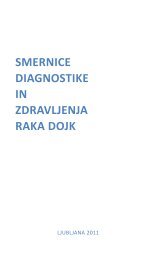Create successful ePaper yourself
Turn your PDF publications into a flip-book with our unique Google optimized e-Paper software.
Experimental model and immunohistochemical analyses<br />
of U87 human glioblastoma cells xenografts in the<br />
immunosuppressed rat brains<br />
Tadej Strojnik 1 , Rajko Kavalar 2 , Tamara T. Lah 3<br />
1<br />
Department of Neurosurgery, Maribor Teaching Hospital, Ljubljanska 5, SI-2000 Maribor,<br />
Slovenia; 2 Department of Pathology, Maribor Teaching Hospital, Ljubljanska 5, SI-2000<br />
Maribor, Slovenia; 3 Department of Genetic Toxicology and Cancer Biology, National<br />
Institute of Biology, Ve~na pot 111, SI-1000 Ljubljana, Slovenia .<br />
Background: To study the neuropathology and selected tumour markers of malignant<br />
gliomas, animal glioma model, developed by using implantation of human glioblastoma<br />
clone U87 into the brain of immunosuppressed Wistar rats.<br />
Methods: U87 cell suspension or precultured U87 tumour spheroids were inoculated<br />
into the brain of 4- week-old rats. Resulting first generation tumours were then<br />
transferred through serial transplantations to rats to get the second and third<br />
generation tumours. Brain tumour sections were examined by routine HE staining<br />
and by immunohistochemical analyses for various known tumour markers.<br />
Results: The tumours induced by injection of spheroids and those developed by<br />
the implantation of tumour tissue grew faster and were markedly larger as those<br />
appearing after injection of U87 cells suspension. The first generation tumours<br />
demonstrated features of an anaplastic astrocytic tumours (WHO grade III), whereas<br />
second and third generations were more malignant, glioblastoma-like tumours<br />
(WHO grade IV).<br />
Immunohistochemical analyses showed that p53, S100 protein, GFAP and<br />
synaptophysin expression, initially present in tissue culture, were gradually lost<br />
in higher tumour generations, whereas nestin and musashi expression increased,<br />
possibly indicating progressive tumour cell dedifferentation. Persistant kallikrein,<br />
CD68 and vimentin expression in U87 cells as well as in all generation tumours may<br />
be related to preservation of the mesenchymal cell phenotype in this tumourigenesis<br />
model. Decreased cathepsins expression indicates lower invasive potential, but<br />
increasing Ki-67 expression marks higher proliferation activity in subsequent tumour<br />
generations. Strong immune reaction for FVIII in second and third generation tumours<br />
correlated with observed increased vascular proliferation in these tumours.<br />
66l47<br />
Conclusions: We established a simple, fast growing and well defined rat animal<br />
model of glioma, which provides a basis for further experimental studies of genetic<br />
and protein expression fingerprints during human glioma tumourigenesis.

















